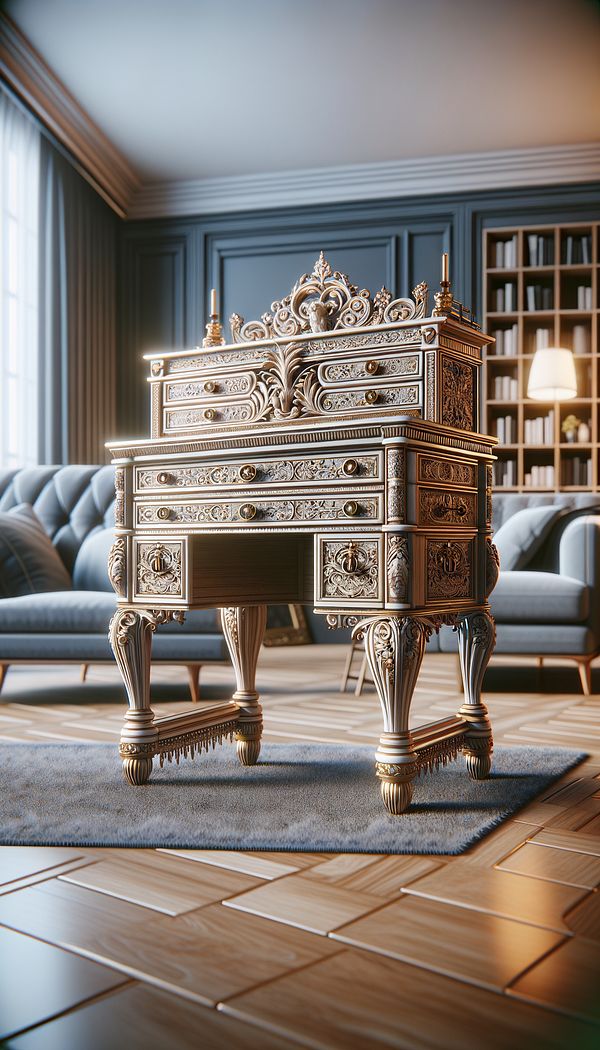What is a Bonheur-du-jour?
A small, elegant writing desk with a variety of compartments.
Description
A Bonheur-du-jour is a charming piece of furniture that emerged in the 18th century, epitomizing the elegance and refined tastes of the time. It is a petite writing desk, often highly ornate, featuring a distinctive arrangement of drawers, shelves, and sometimes cabinets, all designed to neatly store writing materials, letters, and small personal items. The top section typically includes pigeonholes, small drawers, or shelves, while the table surface serves as the writing space, with additional storage provided in drawers underneath.
These desks are known for their exquisite craftsmanship, featuring intricate marquetry, inlays, or gilding, and often made from luxurious materials such as mahogany, rosewood, or satinwood. The Bonheur-du-jour's design not only ensured practicality for writing and organization but also emphasized its decorative aspect, making it a fashionable addition to any interior space, particularly in parlors or studies.
Over time, the Bonheur-du-jour has become a sought-after antique, prized for its beauty and historical significance. While its practical use as a writing desk might have diminished in the modern era, it remains a favorite among collectors and interior design enthusiasts, serving more as a decorative piece that adds a touch of vintage elegance to a room.
Usage
In today's interior design, a Bonheur-du-jour might be placed in a living room or study, not necessarily for its original purpose as a writing desk, but as an elegant decorative piece or to display collectibles. Antique versions of Bonheur-du-jour can also be found in historically themed rooms or homes wanting to capture the essence of 18th-century design.
FAQs
-
When did the Bonheur-du-jour originate?
The Bonheur-du-jour originated in the 18th century, reflecting the period's taste for elegance and practicality in furniture design.
-
What materials are commonly used in Bonheur-du-jour?
Bonheur-du-jour is often crafted from luxurious materials like mahogany, rosewood, or satinwood, and features intricate decorations such as marquetry, inlays, or gilding.
-
Can a Bonheur-du-jour still be used as a writing desk today?
While it's less common due to its size and antique value, a Bonheur-du-jour can still function as a writing desk, especially in settings that appreciate vintage aesthetics or for light, personal writing tasks.
-
How can I integrate a Bonheur-du-jour into modern interior design?
A Bonheur-du-jour can serve as a statement decorative piece in contemporary settings, adding vintage elegance to living rooms, studies, or bedrooms. It can also be used to display decorative items or as a unique vanity desk.
Practical Application
If you're looking to integrate a piece of historical elegance into your space, a Bonheur-du-jour can be a perfect choice. Consider positioning it in a spot where its intricate details can be appreciated up close, such as against a brightly colored wall for contrast or in a well-lit corner of your study or living room. Additionally, while it makes a beautiful decorative piece, don't shy away from using it for its original purpose—granting a special charm to your writing or journaling sessions, for a touch of 18th-century grace in your daily life.
-
Furniture Types599 articles
-
Decorative Objects240 articles
-
Historical Periods & Movements150 articles
-
Spool BeadA decorative small wooden molding featuring a series of round beads.
-
AlcoveAn alcove is a recessed area in a room, often used for additional space or styling.
-
Room DividerRoom divider is a furniture or architectural element that separates spaces within a room.
-
CastersCasters are small wheels or rollers designed to be attached to the bottom of an object to enable it to move easily.
-
HuntboardA huntboard is a type of tall, slender sideboard originally used for serving food in the dining areas of hunting lodges.
